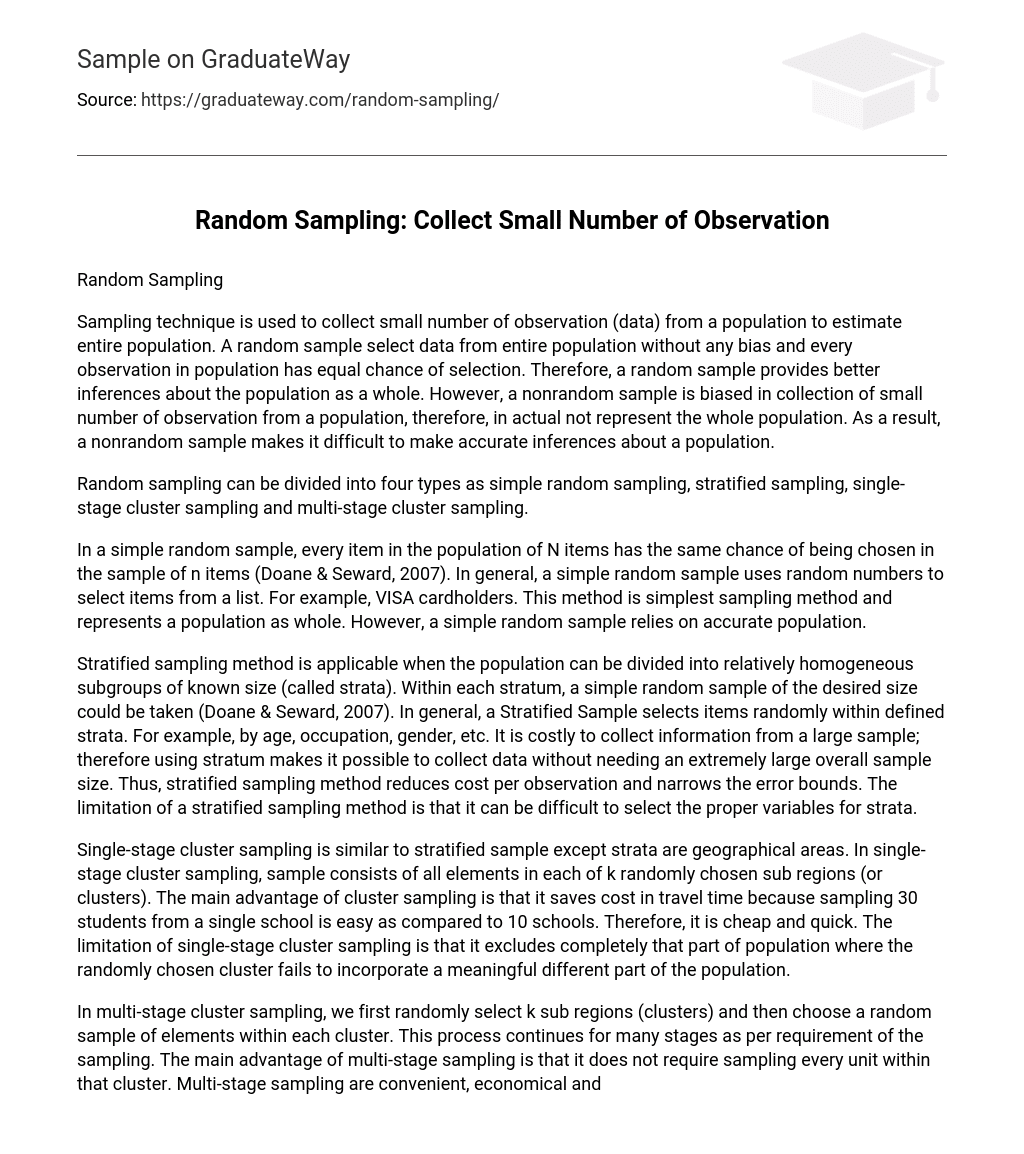Sampling technique is used to collect small number of observation (data) from a population to estimate entire population. A random sample select data from entire population without any bias and every observation in population has equal chance of selection. Therefore, a random sample provides better inferences about the population as a whole. However, a nonrandom sample is biased in collection of small number of observation from a population, therefore, in actual not represent the whole population. As a result, a nonrandom sample makes it difficult to make accurate inferences about a population.
Random sampling can be divided into four types as simple random sampling, stratified sampling, single-stage cluster sampling and multi-stage cluster sampling.
In a simple random sample, every item in the population of N items has the same chance of being chosen in the sample of n items. In general, a simple random sample uses random numbers to select items from a list. For example, VISA cardholders. This method is simplest sampling method and represents a population as whole. However, a simple random sample relies on accurate population.
Stratified sampling method is applicable when the population can be divided into relatively homogeneous subgroups of known size (called strata). Within each stratum, a simple random sample of the desired size could be taken. In general, a Stratified Sample selects items randomly within defined strata. For example, by age, occupation, gender, etc. It is costly to collect information from a large sample; therefore using stratum makes it possible to collect data without needing an extremely large overall sample size. Thus, stratified sampling method reduces cost per observation and narrows the error bounds. The limitation of a stratified sampling method is that it can be difficult to select the proper variables for strata.
Single-stage cluster sampling is similar to stratified sample except strata are geographical areas. In single-stage cluster sampling, sample consists of all elements in each of k randomly chosen sub regions (or clusters). The main advantage of cluster sampling is that it saves cost in travel time because sampling 30 students from a single school is easy as compared to 10 schools. Therefore, it is cheap and quick. The limitation of single-stage cluster sampling is that it excludes completely that part of population where the randomly chosen cluster fails to incorporate a meaningful different part of the population.
In multi-stage cluster sampling, we first randomly select k sub regions (clusters) and then choose a random sample of elements within each cluster. This process continues for many stages as per requirement of the sampling. The main advantage of multi-stage sampling is that it does not require sampling every unit within that cluster. Multi-stage sampling are convenient, economical and efficient (Australian Bureau of Statistics, 2004). Cluster sampling is useful in political polling, and surveys. Multi-stage cluster sampling is often reasonably accurate because people in the same neighborhood tend to be similar in income, ethnicity, educational background, and so on (Doane & Seward, 2007). In case of multi-stage cluster sampling, sampling error can be compounded over single-stage cluster sampling, because error occurs at every level of sampling. Overall, multi-stage sampling is usually less precise than simple random sampling (Garson, 2009).
References:
Doane, D.P. & Seward, L.E. (2007). Applied Statistics in Business and Economics. McGraw-Hill/Irwin: New York
Australian Bureau of Statistics (2004). Education Services – Statistics – A Powerful Edge – Sampling Methods – Random Sampling, 27 August 2004. Retrieved on February 10, 2009 from http://www.abs.gov.au/websitedbs/d3310116.NSF/4a255eef008309e44a255eef00061e57/116e0f93f17283eb4a2567ac00213517!OpenDocument
Garson, G.D. (2009). Sampling. Retrieved on February 10, 2009 from http://faculty.chass.ncsu.edu/garson/PA765/sampling.htm





